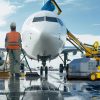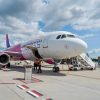 As the number of airlines switching to quieter, larger and more efficient aircraft grows, Honeywell estimates that the number of current generation narrow-bodies sent for dismantlement has increased by 40% over the past three years. Moreover, as next generation aircraft come into service the discarded numbers are likely to increase even further. However, while the activity in the segment increases, the actual profitability of such business is in question.
As the number of airlines switching to quieter, larger and more efficient aircraft grows, Honeywell estimates that the number of current generation narrow-bodies sent for dismantlement has increased by 40% over the past three years. Moreover, as next generation aircraft come into service the discarded numbers are likely to increase even further. However, while the activity in the segment increases, the actual profitability of such business is in question.
Lately the need for more cost- and fuel-efficient aircraft has pushed many operators to put their older machines out of service. According to experts the number of anticipated aircraft retirements over the next 20 years reaches 10 000. However, most discarded models are far from completely exhausted. Since some aircraft are retired after less than ten years’ service, most of them contain serviceable parts that could be used to service similar models.
As a result, a recent survey conducted by Oliver Wyman found a vast majority of airlines (84%) adopting an “active serviceable materials strategy”. MROs have responded effectively to this growth in demand, with almost 80% reporting an “active” or “comprehensive” program and 60% reporting a rise in usage during the past three years. Not surprisingly, more and more parts dealers, lessors, MROs and other industry players seem to be moving into the aircraft disassembly business, rather than relying on independent teardown facilities to feed them.
“The market for pre-owned parts has historically been relatively small, accounting only 10% of all MRO in 2001. However, at the moment, even though understandable caution still remains, growth of the segment over the past decade has brought that figure to 20%,” says Aldas Juronis, the Head of FL Technics Components and Materials Sales Department. “Now, as the useful life of various aircraft models continues to get shorter, the share of surplus parts being sourced directly from part-outs is about 82%. Undoubtedly, such an increase in surplus parts availability is altering strategies for both airlines and maintenance providers, giving them more options than simply going to the OEM. However, while the demand for spare parts remains considerably high, the days of easy money may be coming to an end.”
still remains, growth of the segment over the past decade has brought that figure to 20%,” says Aldas Juronis, the Head of FL Technics Components and Materials Sales Department. “Now, as the useful life of various aircraft models continues to get shorter, the share of surplus parts being sourced directly from part-outs is about 82%. Undoubtedly, such an increase in surplus parts availability is altering strategies for both airlines and maintenance providers, giving them more options than simply going to the OEM. However, while the demand for spare parts remains considerably high, the days of easy money may be coming to an end.”
On the one hand, a growing number of players in the recycling businesses undoubtedly contributes to healthy competition within the segment. On the other hand, however, there are reasons to think that such great involvement in teardowns is only temporary. For instance, some experts believe that growth in dismantling companies will be limited by the demand for used material itself. In fact, according to various statistical data, the potential demand for disassembly might be exaggerated. Rather than emphasizing 600 annual retirements, one might want to acknowledge 300 aircraft have actually been dismantled in each of the last three years. As a result, once used parts for a particular aircraft are in surplus, this will change the business case for more dismantling projects.
Moreover, lately the actual returns from aircraft part-out have become increasingly hard to predict. According to Mr. Juronis, over the last 12 months, the time between receiving an aircraft and putting it back on lease has lessened, proving that the resale market is strong. As a result, currently a company can sometimes earn more from resale than part-out. “The supply of aircraft for part-out has also been constrained by a wave of operators extending leases on aircraft that might previously have been removed from service, so the environment in respective business segments has become more difficult than it used to be. Nevertheless, operators are still clamouring for affordable used parts, so the secret of profitability still lays in being able to properly forecast the demand,” shares the Head of FL Technics Components and Materials Sales Department.





